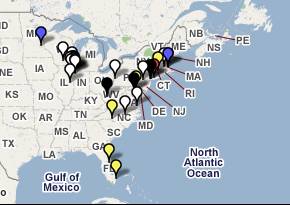 The New Yorker devotes 6,600 meticulously edited words to the impending death of newspapers, examining objectively the promise and perils of a new-media world which writer Eric Alterman sees embodied in the Huffington Post. Drawing on sources ranging from Walter Lippman to The Simpsons, Alterman concludes:
The New Yorker devotes 6,600 meticulously edited words to the impending death of newspapers, examining objectively the promise and perils of a new-media world which writer Eric Alterman sees embodied in the Huffington Post. Drawing on sources ranging from Walter Lippman to The Simpsons, Alterman concludes:
- That the death of newspapers is inevitable;
- That the model that will emerge to replace them looks strikingly like that of the newspapers of 200 years ago; and
- That our democracy is probably better off for this trend, although the plight of people in “the dark” is worse.
Here are some excerpts. Everything is elliptical:
Bill Keller, the executive editor of the Times, said recently in a speech in London, “At places where editors and publishers gather, the mood these days is funereal. Editors ask one another, ‘How are you?,’ in that sober tone one employs with friends who have just emerged from rehab or a messy divorce.”
The McClatchy Company, which was the only company to bid on the Knight Ridder chain when, in 2005, it was put on the auction block, has surrendered more than eighty per cent of its stock value since making the $6.5-billion purchase. Lee Enterprises’ stock is down by three-quarters since it bought out the Pulitzer chain, the same year. America’s most prized journalistic possessions are suddenly looking like corporate millstones. Since 1990, a quarter of all American newspaper jobs have disappeared.
Only nineteen per cent of Americans between the ages of eighteen and thirty-four claim even to look at a daily newspaper. The average age of the American newspaper reader is fifty-five and rising.
It is a point of ironic injustice, perhaps, that when a reader surfs the Web in search of political news he frequently ends up at a site that is merely aggregating journalistic work that originated in a newspaper, but that fact is not likely to save any newspaper jobs or increase papers’ stock valuation.
A recent study published by Sacred Heart University found that fewer than twenty per cent of Americans said they could believe “all or most” media reporting, a figure that has fallen from more than twenty-seven per cent just five years ago, Nearly nine in ten Americans, according to the Sacred Heart study, say that the media consciously seek to influence public policies, though they disagree about whether the bias is liberal or conservative.
Arianna Huffington and her partners believe that their model points to where the news business is heading. “People love to talk about the death of newspapers, as if it’s a foregone conclusion. I think that’s ridiculous,” she says. “Traditional media just need to realize that the online world isn’t the enemy. In fact, it’s the thing that will save them, if they fully embrace it.”
[Huffington Post] is poised to break even on advertising revenue of somewhere between six and ten million dollars annually, according to estimates from Nielsen NetRatings and comScore, the Huffington Post is more popular than all but eight newspaper sites.
The blogosphere relies on its readership, €”its community, €”for quality control.
Most posts inside the [Huffington] site, however, go up before an editor sees them.
Journalism works well, [Walter] Lippmann wrote, when “it can report the score of a game or a transatlantic flight, or the death of a monarch.” But where the situation is more complicated, journalism “causes no end of derangement, misunderstanding, and even misrepresentation.”
When Lippmann was writing, many newspapers remained committed to the partisan model of the eighteenth- and nineteenth-century American press, in which editors and publishers viewed themselves as appendages of one or another political power or patronage machine and slanted their news offerings accordingly.
The twentieth-century model, in which newspapers strive for political independence and attempt to act as referees between competing parties on behalf of what they perceive to be the public interest, was, in Lippmann’s time, in its infancy.
[The piece goes into an analysis of a 1920s debate between Lippman and rival John Dewey over the nature and methods of democratic discourse.]
As the profession grew more sophisticated and respected, top reporters, anchors, and editors naturally rose in status to the point where some came to be considered the social equals of the senators, [P]olitics increasingly became a business for professionals and a spectator sport for the great unwashed
The Huffington Post was hardly the first Web site to stumble on the technique of leveraging the knowledge of its readers to challenge the mainstream media narrative. For example, conservative bloggers at sites like Little Green Footballs took pleasure in helping to bring down Dan Rather after he broadcast dubious documents allegedly showing that George W. Bush had received special treatment during his service in the Texas Air National Guard.
Talking Points Memo “was almost single-handedly responsible for bringing the story of the fired U.S. Attorneys to a boil,” a scandal that ultimately ended with the resignation of Attorney General Alberto Gonzales and a George Polk Award for Marshall, the first ever for a blogger.
During the Katrina crisis, for example, [Talking Points Memo] discovered that some of [its] readers worked in the federal government’s climate-and-weather-tracking infrastructure. They provided the site with reliable reporting available nowhere else.
Traditional newspaper men and women tend to be unimpressed by the style of journalism practiced at the political Web sites, Real reporting, especially the investigative kind, is expensive, they remind us. Aggregation and opinion are cheap.
In October, 2005, at an advertisers’ conference in Phoenix, Bill Keller complained that bloggers merely “recycle and chew on the news,” contrasting that with the Times‘ emphasis on what he called “a ‘journalism of verification,’ ” rather than mere “assertion.”
“Bloggers are not chewing on the news. They are spitting it out,” Arianna Huffington protested, “In the run-up to the Iraq war, many in the mainstream media, including the New York Times, lost their veneer of unassailable trustworthiness for many readers and viewers.”
Newspaper editors now say that they “get it.” Yet traditional journalists are blinkered by their emotional investment in their Lippmann-like status as insiders. They tend to dismiss not only most blogosphere-based criticisms but also the messy democratic ferment from which these criticisms emanate. The Chicago Tribune recently felt compelled to shut down comment boards [because they] “were beginning to read like a community of foul-mouthed bigots.”
[Huffington] predicts “more vigorous reporting in the future that will include distributed journalism, €”wisdom-of-the-crowd reporting, A lot of reporting now is just piling on the conventional wisdom, €”with important stories dying on the front page of the New York Times.”
And so we are about to enter a fractured, chaotic world of news, characterized by superior community conversation but a decidedly diminished level of first-rate journalism.
Before Adolph Ochs took over the Times, in 1896, and issued his famous “without fear or favor” declaration, the American scene was dominated by brazenly partisan newspapers. And the news cultures of many European nations long ago embraced the notion of competing narratives for different political communities, It may not be entirely coincidental that these nations enjoy a level of political engagement that dwarfs that of the United States.
In “Imagined Communities” (1983), an influential book on the origins of nationalism, the political scientist Benedict Anderson recalls Hegel’s comparison of the ritual of the morning paper to that of morning prayer: “Each communicant is well aware that the ceremony he performs is being replicated simultaneously by thousands (or millions) of others of whose existence he is confident, yet of whose identity he has not the slightest notion.” It is at least partially through the “imagined community” of the daily newspaper, Anderson writes, that nations are forged.

 Could the Chicago Sun-Times be the next big city daily to shut down?
Could the Chicago Sun-Times be the next big city daily to shut down?  A landmark event in online journalism occurred in late February, when Talking Points Memo was awarded a George Polk Award for its coverage of the firing of eight United States attorneys.
A landmark event in online journalism occurred in late February, when Talking Points Memo was awarded a George Polk Award for its coverage of the firing of eight United States attorneys. 


